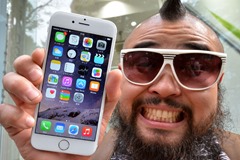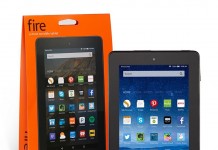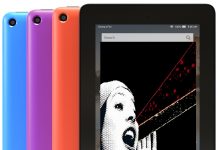 Last week I discussed statistics showing that expensive tablet sales were doubling, inexpensive tablet sales were more or less holding steady, smartphone sales were growing slowly, and PC and e-ink reader sales were declining considerably. Those statistics were interesting, but they didn’t break out tablets into individual brands. However, MarketWatch has an op-ed by Brett Arends that purports to show Apple’s iPad sales are also “plunging.” Arends writes:
Last week I discussed statistics showing that expensive tablet sales were doubling, inexpensive tablet sales were more or less holding steady, smartphone sales were growing slowly, and PC and e-ink reader sales were declining considerably. Those statistics were interesting, but they didn’t break out tablets into individual brands. However, MarketWatch has an op-ed by Brett Arends that purports to show Apple’s iPad sales are also “plunging.” Arends writes:
Sales of iPads plunged by an astonishing 25% over Christmas, the company revealed in Tuesday’s quarterly earnings announcement. Holiday sales of iPads were down to their lowest levels in five years. Not since 2011, when the product was still relatively new, have they been so low.
Arends lays the blame for the iPad’s faltering performance at the feet of its only-slightly-smaller cousin, the “phablet”-sized iPhone 6s and 6s plus. Customers seem to be turning away from the iPad in favor of a phablet. It puzzles him, given that the iPhones cost so much for seemingly so little, but then he admits to not having an iPhone of any kind himself, though he does have an iPad mini and an Apple TV.
Arends thinks that phablets like the iPhone are “the worst of all possible worlds: too big for a phone and too small for a computer.” But by the same token, they’re also large enough to be almost as useful as a tablet, while still being small enough to carry in your pocket.
We already knew people like reading e-books on smartphones despite the tiny size of the screen, simply because they have smartphones with them all the time. E-book fans who might complain about not being able to fit much text on a smartphone’s tiny screen would have less cause to gripe about a phablet; my own Nexus 6’s screen holds only slightly less text than a full-sized Kindle Paperwhite and presumably a six-inch iPhone could do just as well. And given that it offers 1440p resolution—33% better resolution than the full-sized 1080p desktop display on which I’m writing this!—holding it up close to my face to read offers no kind of eyestrain problem at all.
Speaking as a recent phablet owner myself, I’ve suddenly found myself lugging around my gadget bag a lot less, because I just don’t need the Nexus 7 at my disposal anymore. A screen that’s only slightly smaller fits in my pocket, so almost all the things that once made me go for the 7” tablet in my bag can be readily accomplished with the 6” phone on my person. Reading e-books, keeping up with my RSS feed, playing Android games…about the only thing I can’t do as well is write at length, because I can’t fit a full-sized Bluetooth keyboard in my pocket. But the Swype keyboard works surprisingly well for most minor writing tasks. I can readily believe the same could be true for iPad owners and their iPhone 6.
Not everyone will be happy with a screen that size. Some people, including a number of my friends, find phablets just too big to be useful as phones. (It’s not a problem I have, but then I don’t use my phone as a phone all that much.) But more and more people are getting phablets. Even if only half of all smartphone users decide they can live with phablets, that means that half of them are going to be less likely to want a tablet, too, which means iPad sales decline.
But at the same time, those statistics I discussed show inexpensive tablet sales more or less holding steady and expensive tablet sales doubling. There are a couple of reasons for that, I think. First, the devices I call “expensive tablets,” the statistics I cited called “ultramobile” PC products. There really isn’t a good, fully-descriptive name for that category—but it includes the sort of expensive tablets that come with keyboards and occupy effectively the same niche that laptop and notebook PCs used to.
They’re effectively portable devices that harness the full power of a desktop PC, so can be used for all the same business purposes as a PC—something that no cheap tablet or phablet could hope to match. (My brother did just get a smartphone that runs Windows 10 and can be used as a desktop if hooked to a monitor and keyboard—but since it needs that monitor and keyboard for the full PC experience, it remains to be seen how good a replacement that can really be.) So it’s not surprising their sales would go up—they’re not replacing light-use devices like tablets; they’re replacing heavy-use (and heavy and bulky) laptops.
As for the inexpensive tablets, that can be explained by the same cause that drove total device revenue down while keeping total sales numbers steady—people are buying a lot of really cheap tablets, like the Fire, simply because they are so cheap. I don’t think they’re seeing them as direct iPad substitutes though. Someone who’s already sunk a lot of cash into a phablet that meets most of his device needs might not think it’s worth spending several hundred bucks more on an iPad that would do most of the same things they already have a phablet for—but they could see spending $50 on a Fire that could do a few of the same things.
They might also see the Fire as a substitute for an e-ink Kindle, with the side benefit that it can play media and surf the net in addition to reading e-books. For all that e-ink advocates complain that LCD gives them eyestrain or headaches, it seems the average consumer isn’t quite so attached—which is probably the major reason e-ink reader sales have fallen off so precipitously over the last few years once tablets started getting really good.
One study a couple of years ago suggested that phablet use is distinct from either smartphones or tablets—effectively, that they saw much more social networking use than either, but less of all other uses (sports, news & information, games, and playing media) than either. I’m a little doubtful of the study’s conclusions, especially given that so many more phablets have started being sold lately. But we’ll see.
With nearly the same screen size as tablets, and better screen resolution than even full-sized desktop monitors, phablet phones seem to be the form factor of the future when it comes to mobile device ownership in general and e-reading specifically. It should be interesting to see how the next few years of sales statistics turn out.






























I hate to sound like Mr. Fashion, but phablets are for girls and geeks. They’re fine in a purse, so women need have no problem with them. Even the women I know who don’t carry a purse, seem happy to tote their smartphone, constantly picking it up and putting it down. The guy in me hates that. Stuff I carry should stay with me without any conscious thought. (If it doesn’t, I often forget it.) That’s one reason why men’s clothing is filled with pockets, while many women’s outfits don’t even have a pocket big enough for their car keys. The sexes really are different.
A phablet is too big even for men’s pockets other than that of coats. That’s a big turn off for many men who stuff their phones in their pockets. Geeks, of course, like to flaunt their technology. Where once they carried a slide rule in a plastic pocket protector, they now carry a phablet, strapped like a dinner plate to their belt. I like techie stuff, but I also like to be stealthy. Anything valuable that’s easy to see is a thief magnet.
Personal observations:
My iPhone 5 is fine for almost every purpose except perhaps writing on the go, where seeing more than a paragraph at a time is helpful. I’ve played around with the options and concluded that anything over a 4″ screen is no longer suitable for an always with me status. I’ve no interest in Apple or anyone else’s plus sizes. They remind me of the few years back in the 1960s when Detroit made a few combo car-trucks. They bombed because they were good for neither purpose. That’s the phablet, too big for a smartphone and too small for a tablet.
My iPad 3 has taught me a lesson. Its screen is beautiful, but its size and weight means it has no mobility advantages over a small laptop. I still have to carry it about in a bag. I stick with it because I bought it to use with the still-delayed iOS version of Scrivener. It’s greatest advantage is that, when that momentous event happens, I won’t need to ever replace my ancient white MacBook. Apple simply doesn’t make a laptop that’s worth buying. They are too expensive, too stripped of ports, and even replacing the battery is a pain. I see computers as tools not fashion statement. I abhor Sir Ives with ‘thin is beautiful’ fetish.
If a standard-sized smartphone doesn’t do for writing on the go and a full-sized tablet it so large, it’s little different from a laptop, what do I like for writing on the go? Right now, I suspect I’d be happy with the iPad mini. The screen is so high-rez, it has the same pixel dimensions as a full-sized iPad. That should give enough screen real estate for writing.
And one reason why an iPhone makes no sense for writing on the go is that I still need the bulk of a keyboard. One item small and the other large equals a package that is large. I could mate that iPad mini with my folding Palm Bluetooth keyboard for a combination that would fit in two coat pockets or in a pouch under a coat. That would achieve my goal of on-the-go writing that doesn’t mean the bother of carrying something about.
Did I mention that I hate having to remember to carry some bag or other with me? You’re not truly free until your hands are free.
—–
Apple’s problem with tablet sales is partly because it does what other tablet makers often don’t do. It provides a steady stream of OS updates. There’s no need to upgrade hardware to get the latest iOS. At worst you loose a few power features (like a split screen) in the new IOS. Other tablet makers often stick their customers with the OS version it was sold with. Getting new features means getting a new tablet. I hate that throw-away mentality.
——
Teleread might want to do a story about what books are require reading at major universities as reported here:
http://qz.com/602956/these-are-the-books-students-at-the-top-us-colleges-are-required-to-read/
Notice how many are in the public domain. Odd too that Plato’s Republic makes so many lists. I’ve had some 11 years of university education and never had to read it.
–Mike Perry
Too big for a men’s pocket? I carry my Nexus 6 in my jeans or slacks right front pocket all the time with no problems whatsoever. In a case that makes it slightly thicker, yet. It fits there just fine. And I suspect that they wouldn’t sell so well if large numbers of people didn’t feel the same way I do.
Also, it’s funny you say Apple provides a constant stream of updates. Tell that to my first-generation iPad, which can’t even update most of its apps anymore because the versions on the iTunes store are no longer compatible.
“A phablet is too big even for men’s pockets other than that of coats.”
I’ve carried seven-inch tablets in my pants pockets, and still had room for a camera, notepad, pens, and change. And that’s all in the same pocket.
How is a phablet too big, exactly?
In the end there will be a flip model.
[…] the phablet era is done,” Brandt declared. “The sales results indicate phablets may have peaked. Their unique utility—entertainment, book reading and game […]
[…] the phablet era is done,” Brandt declared. “The sales results indicate phablets may have peaked. Their unique utility—entertainment, book reading and game […]
[…] the phablet era is done,” Brandt declared. “The sales results indicate phablets may have peaked. Their unique utility—entertainment, book reading and game […]